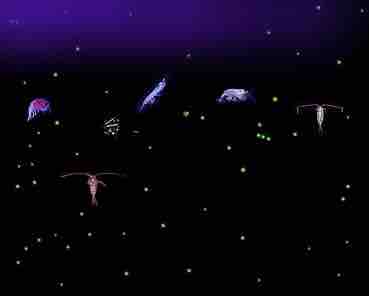Plankton communities are divided into broad categories of producer, consumer and recycler groups. However, determining the trophic level of some plankton is not straightforward. For example, although most dinoflagellates are either photosynthetic producers or heterotrophic consumers, many species are mixotrophic, depending upon circumstances.

Photomontage of plankton organisms
Plankton are any water-column organisms that are incapable of swimming against a current.
Aside from representing the bottom few levels of a food chain that supports commercially important fisheries, plankton ecosystems play a role in the biogeochemical cycles of many important chemical elements, including the ocean's carbon cycle.
Primarily by grazing on phytoplankton, zooplankton provide carbon to the planktic foodweb, either respiring it to provide metabolic energy, or upon death as biomass or detritus. Typically more dense than seawater, organic material tends to sink. In open-ocean ecosystems away from the coasts this transports carbon from surface waters to the deep. This process is known as the biological pump, and is one reason that oceans constitute the largest carbon sink on Earth.
It might be possible to increase the ocean's uptake of carbon dioxide generated through human activities by increasing plankton production through "seeding", primarily with the micronutrient iron. However, this technique may not be practical on a large scale. Ocean oxygen depletion and resultant methane production (caused by the excess production of remineralising at depth) is one potential drawback.
The growth of phytoplankton populations is dependent on light levels and nutrient availability. The chief factor limiting growth varies from region to region in the world's oceans. On a broad scale, growth of phytoplankton in the oligotrophic tropical and subtropical gyres is generally limited by nutrient supply, while light often limits phytoplankton growth in subarctic gyres. Environmental variability at multiple scales influences the nutrient and light available for phytoplankton. As these organisms form the base of the marine food web, this variability in phytoplankton growth influences higher trophic levels. For example, at interannual scales phytoplankton levels temporarily plummet during El Nino periods, influencing populations of zooplankton, fish, sea birds, and marine mammals.
The effects of anthropogenic warming on the global population of phytoplankton is an area of active research. Changes in the vertical stratification of the water column, the rate of temperature-dependent biological reactions, and the atmospheric supply of nutrients are expected to have important impacts on future phytoplankton productivity. Additionally, changes in the mortality of phytoplankton due to rates of zooplankton grazing may be significant.
Freshly-hatched fish larvae are also plankton for a few days as long as they cannot swim against currents. Zooplankton are the initial prey item for almost all fish larvae as they switch from their yolk sacs to external feeding. Fish rely on the density and distribution of zooplankton to match that of new larvae, which can otherwise starve. Natural factors (e.g., current variations) and man-made factors (e.g. river dams) can strongly affect zooplankton, which can in turn strongly affect larval survival, and therefore breeding success.